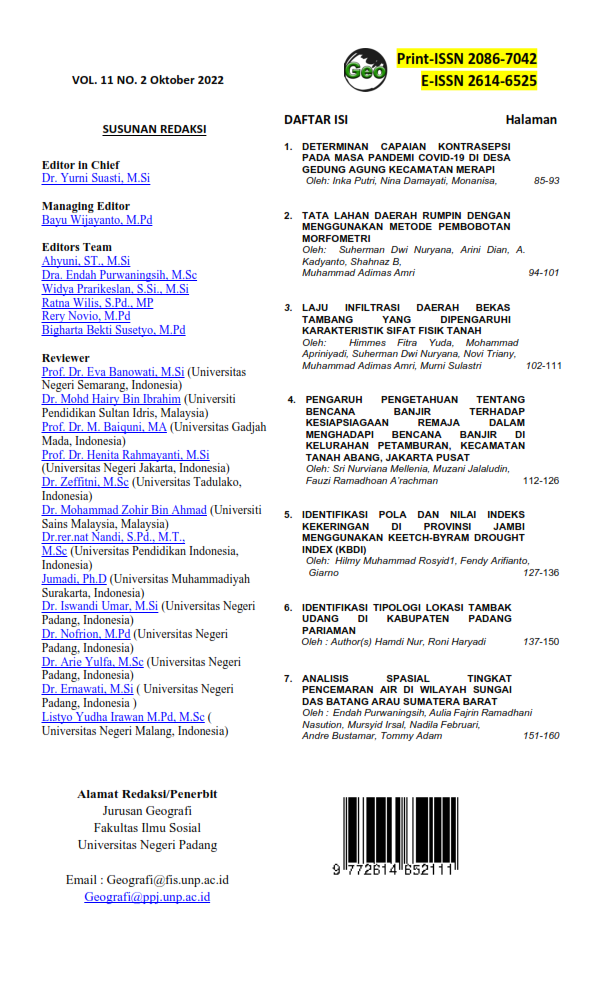DETERMINAN CAPAIAN KONTRASEPSI PADA MASA PANDEMI COVID-19 DI DESA GEDUNG AGUNG KECAMATAN MERAPI
Main Article Content
Abstract
The outbreak of the corona virus disease (Covid-19) was first reported in China, precisely in Wuhan. The government provides a solution by doing large-scale social restrictions which result in restrictions on the number of visits and access to health facilities and makes sexual activities of fertile age couples (PUS) increase because they have more time with each other at home. The purpose of this study was to look at the Social, Economic, and Demographic Conditions of Couples of Childbearing Age during the Covid-19 Pandemic and to find out whether the Covid-19 pandemic affected contraceptive outcomes. The research method used is descriptive quantitative. The population of this study were all couples of childbearing age in Gedung Agung Village, East Merapi District, namely 580 PUS. The samples in this study were 25 couples of childbearing age and 1 PKB informant in the eastern Merapi sub-district. Sampling using purposive sampling technique. Data collection techniques using Questionnaires, Interviews and Documentation. Data analysis using Multiple Linear Regression. The results of the study are (1) Social, Economic and Demographic conditions of PUS with high school education as much as 52%, household work 72%, income 2.500.000 – 3.500.000 52%, classified as multipara 60%, the average contraceptive method used is the contraceptive method. periodic injections (2) Based on the T Test, the factors that affect the achievement of contraception in Gedung Agung Village, East Merapi District, are variables in the number of children and work variables. 44.8% while 55.2% was influenced by other variables.
Downloads
Article Details

This work is licensed under a Creative Commons Attribution-ShareAlike 4.0 International License.
References
Apriani, E., Damayati, N., & Idris, M. (2021). Efektivitas Program Kampung Kb Di Desa Sidorejo Kecamatan Keluang Kabupaten Musi Banyuasin. Jurnal Swarnabhumi, 6(1), 38–45.
Qonita, U., & Arifin, M. (2021). Prosiding Seminar Nasional Kesehatan 2021 Lembaga Penelitian dan Pengabdian Masyarakat Evaluation Of The Family Planning Program ( Kb ) During The Covid-19 Pandemic In 2020 In Prosiding Seminar Nasional Kesehatan 2021 Lembaga Penelitian dan Pengabdian Mas. 227–236.
Khasanah, P. U., Hamzah, A. M., Ashari, M. A., & Nugraheny, E. (2022). Evaluasi Penggunaan Alat Kontrasepsi Pada Masa Pandemi. 8(1), 46–50.
Dasgupta, A., Kantorová, V., & Ueffing, P. (2020). The impact of the COVID-19 crisis on meeting needs for family planning: A global scenario by contraceptive methods used. Gates Open Research, 4, 1–22. https://doi.org/10.12688/gatesopenres.13148.2
Aassve, A., Cavalli, N., Mencarini, L., Plach, S., & Bacci, M. L. (2020). The COVID-19 pandemic and human fertility. Science, 369(6502), 370–371. https://doi.org/10.1126/science.abc9520
Sirait, L. I. (2021). Kunjungan Akseptor KB Di Masa Pande Covid-19 Tentang Pembatasan Sosial Berskala Besar. Prosiding Seminar Nasional STIKES Syedza Saintika, 425–435. http://jurnal.syedzasaintika.ac.id/index.php/PSNSYS/article/view/949
Kumar, D. (2020). Corona Virus: A Review of COVID-19. Eurasian Journal of Medicine and Oncology, 4(2), 8–25. https://doi.org/10.14744/ejmo.2020.51418
Kaseuntung, C., Kundre, R., & Bataha, Y. (2015). E-journal Keperawatan (e-Kp) Volume 3 Nomor 3 Agustus 2015. E-Journal Keperawatan (e-Kp), 3, 1–8.
Matahari, R., Utami, F. P., & Sugiharti, S. (2018b). Buku Ajar Keluarga Berencana Dan Kontrasepsi. In Pustaka Ilmu (Vol. 2). http://eprints.uad.ac.id/24374/1/buku ajar Keluarga Berencana dan Kontrasepsi.pdf
Lumintang, F. M. (2015). Jurnal Emba. Pengaruh Kompensasi Dan Lingkungan Kerja Terhadap Kinerja Pegawai Melalui Motivasi Kerja Pada Balai Pendidikan Dan Pelatihan Keagaaman Manado, 3(3), 683–694.
Arialdi, R., & Muhammad, S. (2016). Pengaruh Urbanisasi, Pendidikan Dan Pendapatan Terhadap Tingkat Fertilitas Di Lima Kota Provinsi Aceh Rendi Arialdi 1* , Said Muhammad 2 1). 1, 208–216.
Leman. M. (2002). Menelusuri Kontrasepsi yang pas. Pustaka Sarwono.
Aningsih, B. S. D., & Irawan, Y. L. (N.D.). ( Mkjp ) Di Dusun Iii Desa Pananjung Kecamatan Cangkuang Kabupaten Bandung Jurnal Kebidanan Vol . 8 No 1. 8(1), 33–40.
Prasetyo, E. S. (2015). Analisis Faktor Yang Berhubungan Dengan Kejadian Drop Out Akseptor KB Kecamatan Gunungpati Kota Semarang. http://lib.unnes.ac.id/id/eprint/20587
Damayati, N., Heldayani, E., & Anggraini, W. (2020). Trends And Fertility Control In South Sumatera Province ( Further Analysis Of Idhs 2017 ). 4(1), 85–90.
Shodiq, M. (2016). Faktor yang Mempengaruhi Rendahnya Kesertaan KB melalui Metode Kontrasepsi Jangka Panjang (MKJP). Prosiding Pertemuan Ilmiah Ikatan Widyaiswara Indonesia, November.
Notoadmojo, S. (2012). Promosi Kesehatan dan Perilaku Kesehatan. PT Rineka Cipta.
Sugiarto, M. B., Muslihatinningsih, F., & Lestari, E. K. (2022). Pengaruh Faktor Sosial Ekonomi Terhadap Tingkat Fertilitas di Provinsi Jawa Timur. 5(2), 18–31.

